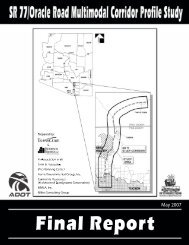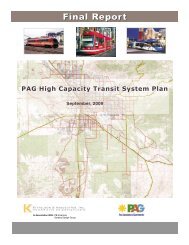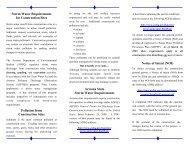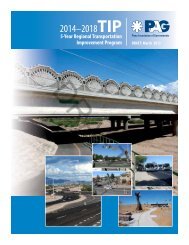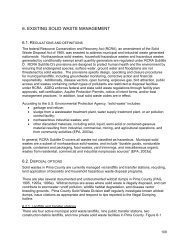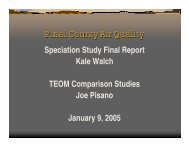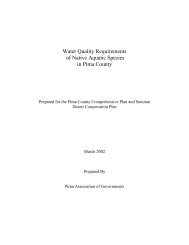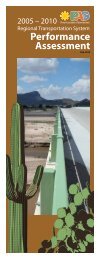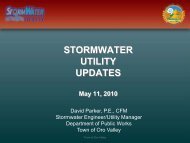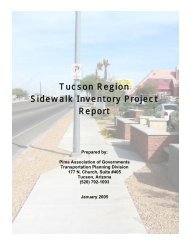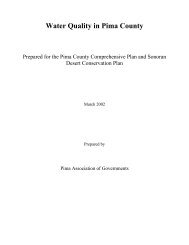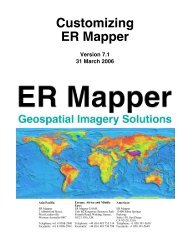Pima County MS4 and the AZPDES Construction Storm Water ...
Pima County MS4 and the AZPDES Construction Storm Water ...
Pima County MS4 and the AZPDES Construction Storm Water ...
Create successful ePaper yourself
Turn your PDF publications into a flip-book with our unique Google optimized e-Paper software.
<strong>Pima</strong> <strong>County</strong> <strong>MS4</strong> <strong>and</strong> <strong>the</strong><br />
<strong>AZPDES</strong> <strong>Construction</strong> <strong>Storm</strong><br />
<strong>Water</strong> Permitting Program<br />
May 5, 2009
Presentation Outline<br />
Clean <strong>Water</strong> Act<br />
<strong>Storm</strong> <strong>Water</strong> Pollutants<br />
<strong>Pima</strong> <strong>County</strong> <strong>MS4</strong> Permit<br />
<strong>AZPDES</strong> <strong>Construction</strong> General Permit
What is storm water?<br />
Precipitation that<br />
accumulates in natural<br />
<strong>and</strong>/or constructed<br />
storage <strong>and</strong> storm<br />
water systems during<br />
<strong>and</strong> immediately<br />
following storm events<br />
<strong>Storm</strong> water runoff,<br />
snowmelt runoff <strong>and</strong><br />
surface runoff <strong>and</strong><br />
drainage
Why is storm water a<br />
problem?<br />
As storm water travels overl<strong>and</strong> <strong>and</strong><br />
through a conveyance system, it carries<br />
pollutants to lakes, reservoirs, rivers,<br />
washes, playas, etc., <strong>and</strong> may degrade<br />
surface water quality in <strong>the</strong> receiving water
Pollutant<br />
<br />
A pollutant means dredged spoil, solid waste,<br />
incinerator residue, filter backwash, sewage, garbage,<br />
sewage sludge, munitions, chemical wastes, biological<br />
<strong>and</strong> non-Atomic Energy Commission radioactive<br />
materials, heat, wrecked or discarded equipment, rock,<br />
s<strong>and</strong>, cellar dirt <strong>and</strong> industrial, municipal, <strong>and</strong><br />
agricultural waste discharged into water.
How is storm water regulated?<br />
Regulatory hierarchy<br />
United States Congress –<br />
Enacts legislation requiring regulations<br />
United States Environmental Protection<br />
Agency (EPA) -Develops regulations<br />
EPA or States – Permitting authority<br />
issues <strong>and</strong> enforces permits<br />
Regulated Entities<br />
Implement permit requirements
Regulatory History<br />
1948 Federal <strong>Water</strong> Pollution Control Act<br />
(FWPCA) created to address pollution of<br />
interstate waters <strong>and</strong> tributaries<br />
United States Environmental Protection<br />
Agency (EPA) established in 1970<br />
1972 FWPCA amendments referred to as<br />
<strong>the</strong> Clean <strong>Water</strong> Act (CWA) created<br />
NPDES
What is NPDES?<br />
NPDES is <strong>the</strong> National Pollutant Discharge<br />
Elimination System permit program<br />
CWA prohibits <strong>the</strong> discharge of any<br />
pollutant to waters of <strong>the</strong> United States<br />
from a point source unless <strong>the</strong> discharge is<br />
authorized by a NPDES permit
What is an <strong>MS4</strong>?<br />
Municipal Separate <strong>Storm</strong> Sewer System<br />
(<strong>MS4</strong>)<br />
An <strong>MS4</strong> is a system of conveyances (e.g.,<br />
storm drains, roads, curbs, man-made<br />
made<br />
channels):<br />
Owned or operated by a public body<br />
Designed for collecting storm water<br />
Not a combined sewer<br />
Not a Publicly Owner Treatment Works
Is runoff from an <strong>MS4</strong> a point<br />
The <strong>MS4</strong> has a<br />
multitude of discharge<br />
points throughout <strong>the</strong><br />
<strong>County</strong>. Uhhh, , no?<br />
source?<br />
Yes. The 1987 <strong>Water</strong> Quality<br />
Act designated urban storm-<br />
water runoff as a point<br />
source discharge of<br />
pollutants to waters of <strong>the</strong> US
NPDES Regulations<br />
1990 EPA regulations established permit<br />
application process for Phase I sources:<br />
Medium Municipal Separate <strong>Storm</strong> Sewer Systems<br />
(<strong>MS4</strong>) (serving populations 100,000 ≤ 249,999)<br />
<strong>Construction</strong> sites disturbing over 5 acres<br />
<strong>Pima</strong> <strong>County</strong> began permit process in 1991,<br />
<strong>MS4</strong> permit issued by <strong>the</strong> EPA in 1997
NPDES Regulations<br />
1999 Phase II Final Rule – O<strong>the</strong>r sources<br />
<strong>Construction</strong> sites ≥ 1 acre<br />
Arizona received authorization from <strong>the</strong><br />
Environmental Protection Agency to<br />
operate <strong>the</strong> NPDES program at <strong>the</strong> state<br />
level in 2002 establishing <strong>the</strong> Arizona<br />
Pollutant Discharge Elimination System<br />
(<strong>AZPDES</strong>) Permit Program
Why does PDEQ inspect<br />
construction sites?<br />
<strong>Pima</strong> Count NPDES <strong>MS4</strong> Permit, Section 5.2.2.1<br />
<strong>Construction</strong> Site Inspections<br />
Visit 25% of all construction sites started within any one<br />
year that are required to submit a NOI<br />
<br />
<br />
<br />
Verify <strong>the</strong> existence of NOI <strong>and</strong> SWPPP<br />
Any review of SWPPP adequacy is incidental to inspection<br />
done for o<strong>the</strong>r purposes<br />
If PDEQ observes that <strong>the</strong> site is out of compliance,<br />
ADEQ may be notified
<strong>Construction</strong> Permit<br />
Requirements<br />
Develop <strong>Storm</strong>-<strong>Water</strong> Pollution Prevention<br />
Plan (SWPPP) that includes Best Management<br />
Practices (BMPs) to minimize discharge of<br />
pollutants in storm water from <strong>the</strong> site<br />
Submit Notice of Intent to discharge to ADEQ<br />
Implement SWPPP<br />
Install BMPs for erosion <strong>and</strong> sediment control at site<br />
Conduct inspections according to schedule in SWPPP<br />
Repair <strong>and</strong> maintain BMPs<br />
Maintain records
What is a SWPPP?<br />
A document that describes site-specific<br />
specific<br />
controls that will be installed,<br />
implemented <strong>and</strong> maintained to control<br />
<strong>the</strong> discharge of pollutants in storm<br />
water from your construction site.
SWPPP Review<br />
<strong>Pima</strong> <strong>County</strong> does not review or “approve”<br />
a <strong>Storm</strong> <strong>Water</strong> Pollution Prevention Plan<br />
(SWPPP) for projects within our jurisdiction<br />
prior to construction activities<br />
Why not? <strong>Pima</strong> <strong>County</strong> does not have<br />
authority to enact an ordinance that would<br />
require SWPPP submittal <strong>and</strong> approval<br />
PDEQ reviews SWPPPs at construction sites
SWPPP Preparation<br />
Considerations<br />
Potential onsite pollutant sources<br />
Where potential pollutants may<br />
discharge offsite (outfalls)<br />
How to control potential<br />
pollutant discharge (BMPs!)
Types of <strong>Storm</strong> <strong>Water</strong> BMPs<br />
The three general types of storm water ground<br />
controls, or best management practices (BMPs):<br />
Erosion Prevention – Preventing sediment<br />
from being entrained in storm water from<br />
disturbed soil<br />
Sediment Control –Devices that prevent<br />
eroded sediment from leaving <strong>the</strong> site<br />
Materials <strong>and</strong> Waste Management Control<br />
– BMPs that control industrial type materials<br />
<strong>and</strong> waste
I. Erosion Control<br />
Phasing -Sequence soil disturbing activities to<br />
reduce <strong>the</strong> exposure time of bare soil<br />
Keep native vegetation <strong>and</strong> soil cover –<br />
clearing <strong>and</strong> grading increase soil erosion<br />
rates up to 1,000 X<br />
Vegetate, mulch, or o<strong>the</strong>rwise stabilize all<br />
exposed areas as soon as l<strong>and</strong> alterations have<br />
been completed or when site is inactive for 14<br />
days or more<br />
Rough grade or terrace slopes
II. Sediment Control –<br />
Velocity Dissipation Devices<br />
Silt fences, straw bales, or straw waddles impede <strong>the</strong><br />
flow of water <strong>and</strong> create a still body of water upslope of<br />
<strong>the</strong> device to allow sediment to settle out <strong>and</strong> slowly let<br />
clean water pass through <strong>the</strong> openings in <strong>the</strong> device
II. Sediment Control –<br />
Velocity Dissipation Devices (cont.)<br />
Sediment basins collect runoff <strong>and</strong> allow <strong>the</strong><br />
water to pond <strong>and</strong> sediments to settle out
II. Sediment Control: Track Out–<br />
preventing offsite sediment<br />
tracking<br />
Track out pad – large<br />
stones scrape sediment off<br />
tires as <strong>the</strong> vehicle rolls<br />
over <strong>the</strong>m<br />
Wash sediment<br />
off tires at exits
III. Materials <strong>and</strong> Waste<br />
Management Control<br />
Good Housekeeping – Properly dispose of<br />
used construction materials <strong>and</strong> o<strong>the</strong>r garbage<br />
Use <strong>and</strong> enforce designated concrete washout<br />
areas
What I Look for During a<br />
<strong>Storm</strong> <strong>Water</strong> Inspection<br />
Verify that <strong>the</strong> project has obtained<br />
authorization to discharge storm water<br />
Review <strong>the</strong> site-specific specific <strong>Storm</strong> <strong>Water</strong> Pollution<br />
Prevention Plan (SWPPP) for permit compliance<br />
Verify that <strong>the</strong> BMPs required by <strong>the</strong> SWPPP<br />
have been implemented <strong>and</strong> maintained by<br />
conducting a site walk
Bill’s s Top Ten List of<br />
Compliance Issues
10. No NOI submitted for <strong>the</strong> site
9. Site does not have a SWPPP<br />
prepared
8. SWPPP Certification page is<br />
not signed
7. Improperly installed BMPs
6. Improperly maintained BMPs
5. SWPPP is incomplete, e.g.,<br />
Does not identify responsible party for onsite<br />
SWPPP implementation<br />
Copy of permit not included<br />
No inspector qualifications<br />
No sequence of activities<br />
No description of interim/permanent<br />
stabilization practices<br />
Receiving water not identified
4. Site map is incomplete <strong>and</strong><br />
does not show, e.g.,<br />
Directions of storm-water flow<br />
Disturbed <strong>and</strong> undisturbed areas<br />
Locations of BMPs<br />
Locations of expected stabilization practices<br />
Locations of storm-water discharges
3. No signage at site entrance
2. SWPPP is not updated as site<br />
conditions change during<br />
construction
1. Regular inspections are not<br />
conducted as required by <strong>the</strong><br />
permit
Information<br />
Arizona Department of Environmental Quality<br />
– <strong>AZPDES</strong> <strong>Storm</strong>water Program:<br />
http://www.azdeq.gov/environ/water/permits/stormwater.html<br />
<strong>Pima</strong> <strong>County</strong> Department of Environmental<br />
Quality – <strong>Storm</strong> <strong>Water</strong> Program:<br />
http://www.deq.pima.gov/water/stwmgmprog.html



